|
MSR REMOTE TENT
TEST SERIES BY MIKE CURRY
LONG-TERM REPORT
July 05, 2017
CLICK HERE TO SKIP TO THE FIELD REPORT
CLICK HERE TO SKIP TO THE LONG-TERM REPORT
TESTER INFORMATION
|
NAME:
|
Mike Curry
|
|
EMAIL:
|
thefishguy AT hotmail DOT com
|
|
AGE:
|
47
|
|
LOCATION:
|
Tacoma, Washington USA
|
|
GENDER:
|
M
|
|
HEIGHT:
|
5' 11" (1.80 m)
|
|
WEIGHT:
|
190 lb (86.20 kg)
|
I've been backpacking, climbing, ski-packing, bushwhacking, and snowshoeing throughout the mountains of Oregon and Washington for over 25 years. I'm an all-season, all terrain, off-trail kind of guy, and enjoy everything from casual hikes with my children to mountaineering and alpine rock climbing in the Pacific Northwest. While I've carried packs (with winter climbing gear) in excess of 70 pounds (32 kilos), the older I get the more minimalist I become.
INITIAL REPORT
PRODUCT INFORMATION & SPECIFICATIONS
Manufacturer: Cascade Designs, Inc.
Year of Manufacture: 2017
Manufacturer's Website: www.msrgear.com
MSRP: US $799.95
Listed Packed Weight: 6 lb 15 oz (3.15 kg)
Listed Minimum Weight: 6 lb 8 oz (2.95 kg)
Measured Packed Weight (as received): 6 lb 15.9 oz (3.17 kg)
Other details:
Packed size (as received): ~20 x 7 in (51 x 17 cm)
Floor area ~33 sq ft (3.1 sq. m)
9 stakes provided
7 guy lines provided
Additional specifications can be found at manufacturer's website (see link above).
Footprint also provided by manufacturer, available separately.
Footprint details:
MSRP: None listed
Measured Weight:: 7.7 oz (218 g)
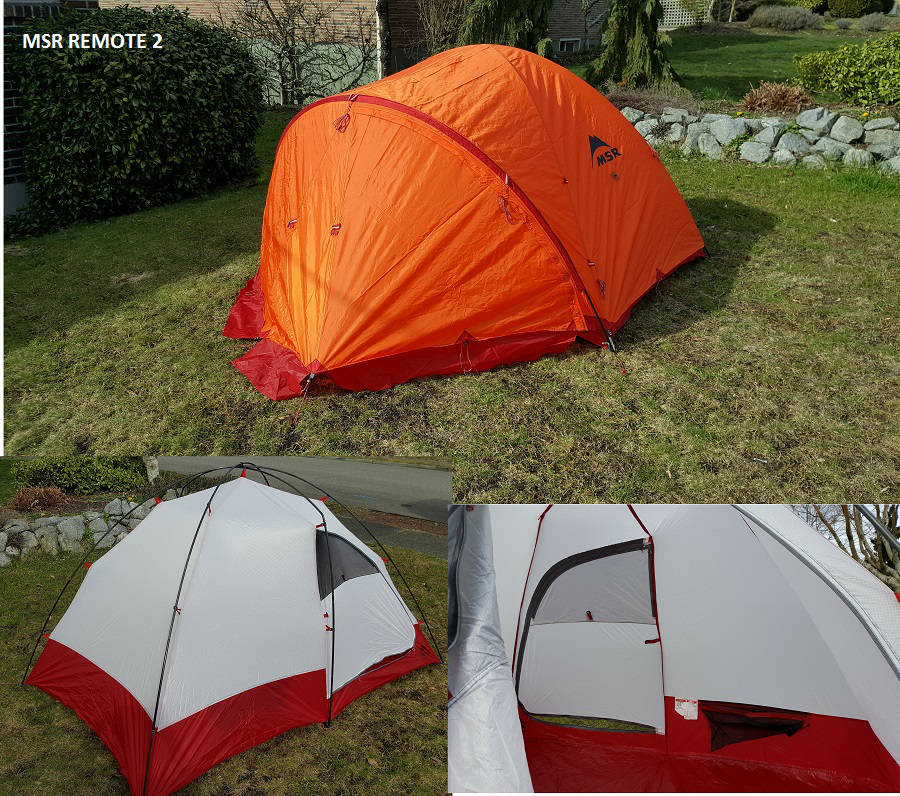 | | MSR Remote 2 (setup) |
INITIAL IMPRESSIONS
The MSR Remote 2 tent caught my attention from the moment I opened the box.
The first thing I noticed was that, instead of the usual stuff-sack, the MSR Remote 2 comes in a bag that has a cinch-cord opening not at its end, but at it's top, with a large flap that covers the contents before cinching. Since I've always liked the convenience of being able to stuff and cram my tent into a stuff sack in the morning, we'll see how I feel about this sort of carry bag. The carry bag has two compression straps sewn to it.
Looking over the materials and construction, the Remote 2 appears to be made of the usual materials, identifed at the manufacturer's website as 68D ripstop polyester fly (1800mm polyurethane & DWR finish), 40D ripstop nylon upper tent section (with DWR), 15D nylon micro-mesh windows, and 40D ripstop nylon for the floor (with 10,000mm Durashield polyurethane & DWR finish), and the construction quality seems very good. No bad seams, loose threads, missed stitching, or other construction defects were noted.
After setting up the Remote 2 in my front yard, I was immediately taken by two features: its floor space and its headroom. Most two-person tents I have owned have been best described as "snug" for two people. Not the Remote 2. My immediate thought was "wow, this could actually hold three people side-sleeping in an emergency," The third pole for the tent spreads the roof out at the top, creating a sense of spaciousness I haven't had in other 2 person tents I've owned.
The tent itself is a light hued upper with a burgundy lower section and floor. Two primary poles run from one corner of the tent to the opposite corner, with the poles connected in the middle by a permanent hub (so it could be considered one x-shaped pole, but for convenience I will refer to them as the two main poles) The poles are described at the manufacturer's website as being "ultra-durable Easton Syclone Poles," and they appear to be made of some type of carbon fiber with aluminum inserts. A third pole runs under these creating the spacious headroom across its width. All these poles are inserted into grommets on the stakeout tabs, and the tent is attached with plastic clips (no sleeves), which I love for convenience. A fourth pole is used in the vestibule, and is inserted in a sleeve in the vestibule, creating a spacious overhead area outside one side of the tent.
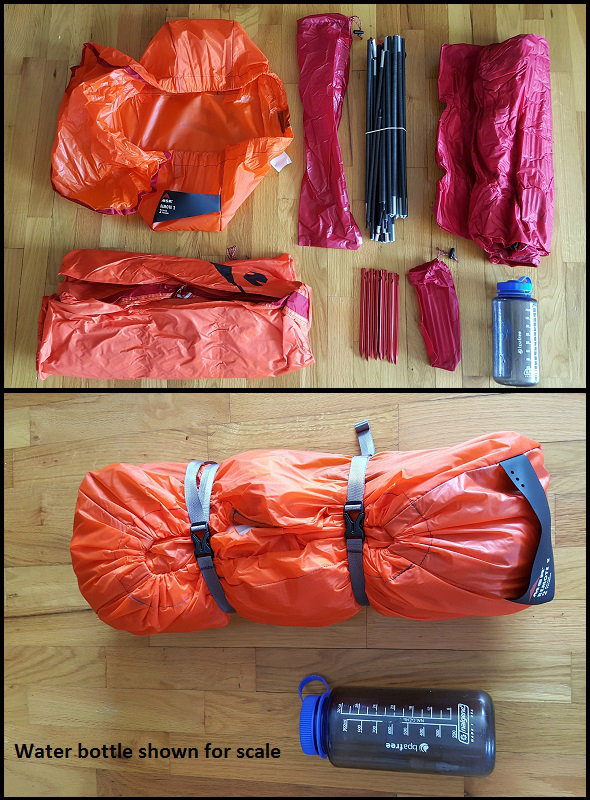 | | MSR Remote 2 (as received) |
The vestibule was equally impressive. It is asymmetrical, providing a small space outside one door of the tent, and a large space outside the other side of the tent (the user can choose either side of the tent for setting up the larger vestibule). I like a spacious vestibule, as it helps me keep my gear out of the weather, and on alpine climbs that can be a lot of stuff. This vestibule does not disappoint in terms of its floor space and volume. My first thought, in fact, was that in a real emergency a 4th person could sleep within the vestibule. The fly is a bright orange, which I appreciate for safety/visibility reasons (not to mention being cheery in foul weather), but may not be ideal for use in locations where the high visibility might detract from other people's enjoyment of the outdoors.
Aside from the major items above that immediately jumped out at me, the Remote 2 has a number of other features that I find helpful/useful:
*Lots of guy line points on the fly (helpful in stabilizing the tent in high winds)
*Color-coded pole ends for easy setup
*Reflective cord stake loops on tent, fly, and footprint
*Screened vent windows at the top of the doors
*Two-way zippers on doors and windows
*Loops on the roof seams to allow the attachment of an attic or cords for hanging items
*A sewn-in stash net on each side of the tent (visible in photo of interior)
*A rectangular floor with doors on opposite sides (allowing two people to sleep head-to-foot conveniently)
*Loops and toggles to tie back doors and windows
*Highly reflective guy line loops and lines
*Optional footprint's carry bag is sewn to the footprint so it doesn't get lost
Overall, my initial impression was this is a well-designed and well-constructed tent I can't wait to try in the field!
READING THE INSTRUCTIONS
The MSR Remote 2 did not come with any instructions, however a one-page .pdf download is available at the website, as is a FAQ that answers many basic questions like tent care.
I found the initial setup to be intuitive, and the instructions pointed out the two key things I might have otherwise done incorrectly: first, that the third tent pole goes underneath the two main poles (next to the hub), not over it; and second, the upper clips on the third tent pole go under the red disk on the pole assembly. There were, however, two questions that I was left with while setting up the tent (which I'll discuss in the next section).
The assembly instructions do state "For complete care and use instructions, refer to the Owner's Manual (available at www.msrgear.com/Remote2). I was unable to find an Owner's Manual, but found the FAQ to contain the information I would expect to find in one.
TRYING IT OUT
After looking the tent over closely indoors, I took advantage of a break between rain showers to set the Remote 2 up in my front yard.
Initial setup was intuitive for me, with my two main questions being answered by the instruction sheet (third pole for tent goes under the main poles, and the upper clips on that pole go under the red disks.
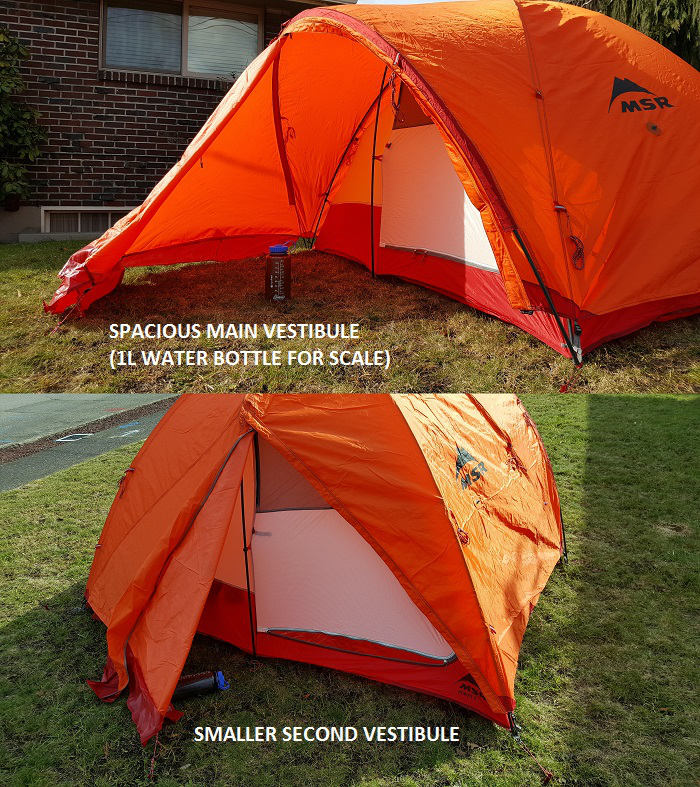 | | MSR Remote 2 (vestibules) |
Only two things left me with questions. First, the hub has a small side and a large side. Nothing states which is supposed to face down. Since it isn't mentioned, perhaps it isn't important. I elected to place the small end up, as it seems to be less likely to abrade against the fly than the larger side. Also, there is a clip at the top of the tent, and it isn't entirely clear to me which of the three poles it should clip to. It can easily be clipped to either the "third" pole, or the lower of the two main poles. Again, this may not be important. I did find that clipping it to the "third" pole lowered it slightly so that it wasn't rubbing against the lower of the main poles, so I'll likely try that approach initially.
One thing that I found interesting is that complete setup requires 7 stakes (9 are provided). Four at the corners of the tent, one on the small vestibule side, and two on the large vestibule side of the fly (as the large side of the vestibule's footprint shape is a trapezoid). The trapezoid shape gives more usable room in the vestibule, but requires a minimum of 7 stakes be carried (to ensure the vestibule isn't flapping in the breeze).
On the subject of the fly, one thing I always worry about with tents is how they will perform in the wind. I've had members of my climbing party have brand new mountaineering tents shred in some of the winds I've encountered, usually due to not being able to guy it out to prevent flapping in the wind. The fly of the Remote 2 has 16 guy line points (14 sewn into seams, 2 welded-through on the ends) and 4 additional staking points (that aren't strictly required to erect the tent). This gives lots of options, and reflective guy line with aluminum slide adjusters are included on 7 of the guy line points. The straps that connect the fly to the main tent poles at the corners have slide adjusters, so there appear to be lots of options for securing the tent in high winds.
Climbing into the tent, I was immediately struck by how roomy it felt. My son is a little taller than I am, and he can stretch out without touching the ends of the tent. We're both pretty big, and there was clearly room for both of us and any essential items we wanted to bring into the tent. The headroom felt spacious, even with us both sitting up. My initial assessment was that I'd rather be pinned down by weather in this tent than any other I currently own, if only for its spacious interior and vestibule.
I did not take the time in my initial setup to guy out the tent as my time was limited.
I did find putting the tent back in the carry bag more challenging initially than a traditional stuff-sack. Since I usually split the tent components with a partner, I don't anticipate this being a significant concern, but will make note of any problems during testing.
SUMMARY
The MSR Remote 2 tent appears to be an exceptionally well-designed and well-constructed tent. It gives an amazingly spacious feel both inside the tent and in the main vestibule. It has all the features I'd look for in a mountaineering tent and more, and I look forward to seeing how it performs in the field.
FIELD REPORT
FIELD LOCATIONS AND CONDITIONS
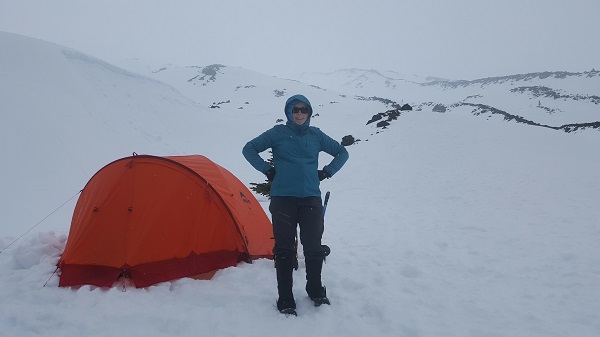 | | My daughter on Mt. St. Helens, just before the rains hit |
During field testing, I have used the MSR Remote tent on two outings totaling 4 nights.
The first two nights were just above treeline on Mt. St. Helens in Washington State, a camp that was on the Worm Flows route at approximately 4,000 ft (1,219 m). The other two nights were just above Moon Rocks at approximately 9,000 ft (2,743 m) on Mt. Rainier (upper Muir Snowfield).
The Mt. St. Helens camp had mild temperatures (just above freezing) the entire time, with significant winds and rain overnight. I would estimate rainfall at almost an inch (2.5 cm), and winds were reported to be sustained at 35 mph (56 kph), with gusts to 45 mph (72 kph).
The Mt. Rainier trip had cooler temperatures (daytime just above freezing, nighttime temps around 20 F (-7 C), and only a light breeze and no precipitation but heavy fog.
I shared the tent with one other on both trips, and both campsites were on snow.
PERFORMANCE IN THE FIELD
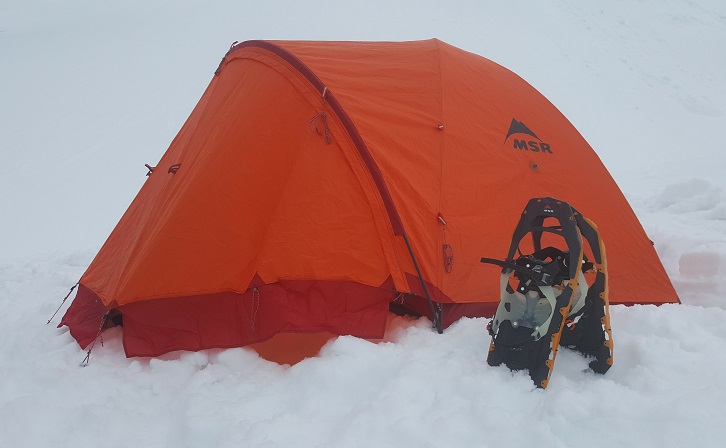 | | MSR Remote 2 above the timberline (large vestibule side) |
The MSR Remote was simply amazing on both these trips.
SETUP:
This was the most challenging aspect of testing so far. Setting up the tent went fine on Mt. Rainier, but on Mt. St. Helens (where I was joined by my daughter) it was a bit trickier. To be fair, this was challenging due primarily to the combination of conditions and my limited experience with the tent. My daughter was with me on that trip, but I limited her assistance to making sure the tent (and later the fly) didn't blow away. The snow conditions required burying snow stakes as deadmen, and this required a few re-adjustments to get it secure and tight on the snow platform. Once I got the footprint and tent staked out, erecting the poles for the tent went pretty smoothly.
The real challenge for me was maintaining control of the fly once the fly's pole was inserted. This created a bit of a sail effect that was a bit frustrating. I have a few ideas of what I'll try next time to make that easier, like connecting the fly on the upwind side prior to inserting the pole, as I'm pretty sure I did it in the most difficult way possible.
COMFORT:
I've owned a number of climbing and backpacking tents over the years, and I have never, ever, ever had a two-person tent that felt this spacious and roomy. On Mt. St. Helens, we turned in early when the rain started falling. I opened the large vestibule door and cooked our dinner from the comfort of the tent, well-protected from the weather. After dinner we buttoned things up, pulling all our gear easily into the vestibules (with room to spare, despite all our winter climbing gear).
I typically will build a foot pit outside my tent door when camped on deep snow, so I can sit on the tent floor with my feet down in the pit. The large vestibule was so large I was able to fit that, a small cooking platform, and all our gear in the vestibule with room to spare!
Inside the tent, the sense of spaciousness was equally amazing. I get stir crazy in a tent most of the time, and I can say with absolute certainty that if I ever have to be pinned down in a tent for days on end in the mountains, I'd want to be in this one over any other tent I've ever owned.
It is not so much that the tent is huge (it is "roomy" for two, but not enormous), but that the space includes a lot of headroom and enough extra perimeter to make it feel spacious to me. The configuration, the mesh storage areas that are sewn in, and the hang loops near the top give a lot of options for keeping those things that keep me comfy for the long term (lights, cards, clothing, etc.) handy.
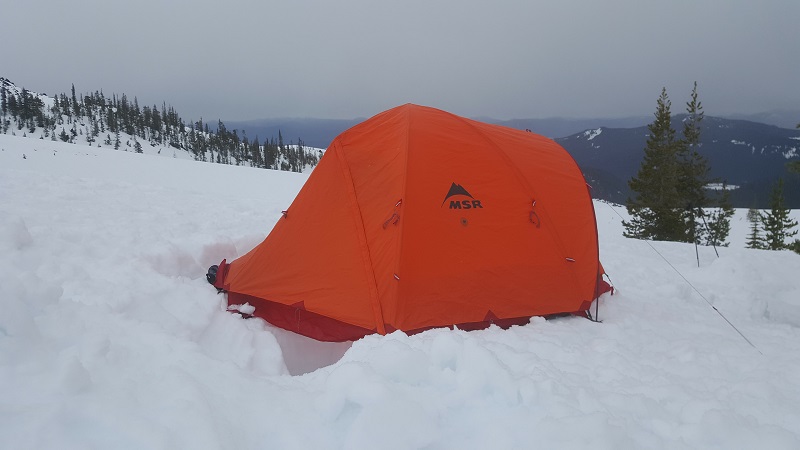 | | MSR Remote 2 (small vestibule side) |
WIND:
Aside from the challenges with pitching that I described above, my experience on Mt. St. Helens with the wind was outstanding. I only had two additional stakes beyond those required, so I only guyed out the upwind side of the tent. Despite this, the tent felt rock-solid, and the wind "whipping" from slack was minimal (less than my other primary tent even when it is fully staked out!).
RAIN:
Bombproof. Despite the wind-driven rain on Mt. St. Helens, we stayed dry. When I took the tent down, there was a pool of water on top of the footprint between it and the tent floor. None entered the tent.
CONDENSATION:
None on the Mt. Rainier trip, but some minor condensation on Mt. St. Helens, which was probably a combination of the high humidity (it was raining) and the fact we forgot to open the vents (windows) at the top of the door (which I usually do to reduce condensation).
OTHER:
I wanted to comment on the tent colors. They're perfect. I've been in tents of many different colors, including high- and low-visibility. I think this color combination is perfect, at least for my typical use. It is high-visibility from the outside, making it easy to spot, but inside it is cheery, rather than obnoxious.
SUMMARY
My initial experiences of using the MSR Remote 2 tent have been amazing. Though I made some errors that made setting it up in high wind a bit tricky, overall it was easy to set up. The wind and rain resistance was outstanding, and the tent feels quite roomy compared to others I've used. I'm more confident in the performance of this tent in challenging alpine environments over any other tent I've ever owned.
LONG-TERM REPORT
LONG-TERM TEST LOCATIONS AND CONDITIONS
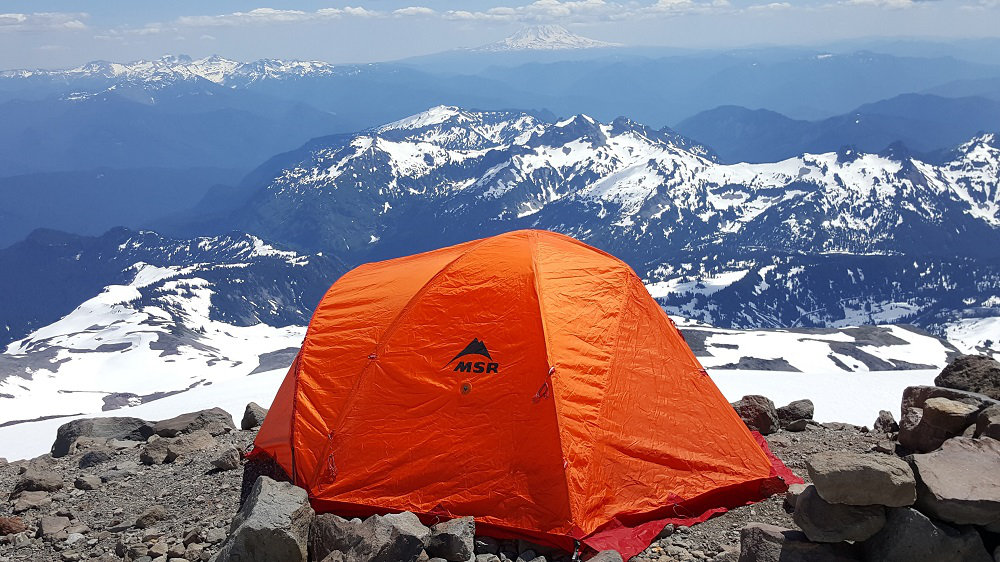 | | MSR Remote 2 looking down on the Tatoosh Range |
The MSR Remote has been my go-to tent for spring climbing trips this year, and has seen an additional 5 nights use during long-term testing. Three nights were in Mt. Rainier National Park well above tree-line (~10,000 ft/3,048 m in the Anvil Rock/Camp Muir area) while I was training, and two additional nights below tree-line, also in Mt. Rainier national park.
Long-term testing campsites were both on snow-covered glaciers and on rocky outcrops. While I did not encounter any precipitation during long-term testing, I did encounter winds that I would estimate exceeded 40 mph (64 kph).
PERFORMANCE IN THE FIELD
My opinion of the MSR Remote 2 tent was good coming into the long-term testing period, and it's only gotten better. While it remains the heaviest two-person tent I own, split between two people it weighs in at just under 4 lb (1.81 kg) each, which is a small price to pay for those trips when a spacious, bomber tent is what I want.
One evening on Mt. Rainier I encountered weather very similar to the weather I encountered on Mt. Hood two years ago: a bright, sunny day with wicked SW winds developing in the evening and gusting near 45 mph (72 kph), and sustained speeds that were not much lower. On the Hood climb two years ago, we actually lost one tent entirely to the wind, and had two new tents (by a well-known climbing tent manufacturer) shred to pieces on the exposed ridge.
In conditions and a setting I'd describe as almost identical to that trip, the MSR Remote 2 held its ground with ease. While I did guy the fly out, that was primarily to prevent flapping by taking the slack out. I felt totally secure in the tent, and found the bright glow inside to be cheery and reassuring as the winds whipped around me.
Another new experience during long-term testing was that I had the opportunity to test the tent on a rock platform. I'd been concerned that with the large footprint of the vestibules, it might be difficult to position the tent on the rock settings I generally encounter (which tend to be small platforms for small tents). I found that I was able to take the smallest of three platforms available, and even though the fly covered a few of the rock windbreaks that had been stacked up, I was easily able to route it such that it was still taut enough to resist the winds.
SUMMARY
 | | MSR Remote at Anvil Rock - Mt. Rainier summit in background |
The MSR Remote 2 is a robust and roomy 2 person tent that is well suited to alpine environments where exposure to precipitation and winds is high, and retreat not easy. More than any tent I've ever owned I find it to hit a sweet spot between roominess and livability, reasonable pack weight, and the ability to take whatever mother nature can throw at it. It has great features that lend itself to long stays in alpine environments, like lots of headroom, good storage options, and enough vestibule space to keep all my gear out of the elements.
CONTINUED USE
Will I continue to use the MSR Remote 2 tent? Absolutely. In fact, next week I'm heading out for a summit attempt on Mt. Rainier, and that's the tent I'll be taking. It's proven itself worthy of all my major alpine climbs, and is no doubt going to see a lot of use in the future!
I'd like to thank Cascade Designs, Inc. and BackpackGearTest.org for the opportunity to test the Remote 2 tent. This concludes my report.
This report was created with the BackpackGearTest.org Report Writer Version 1.
Copyright 2017. All rights reserved.
Read more gear reviews by Mike Curry
|




